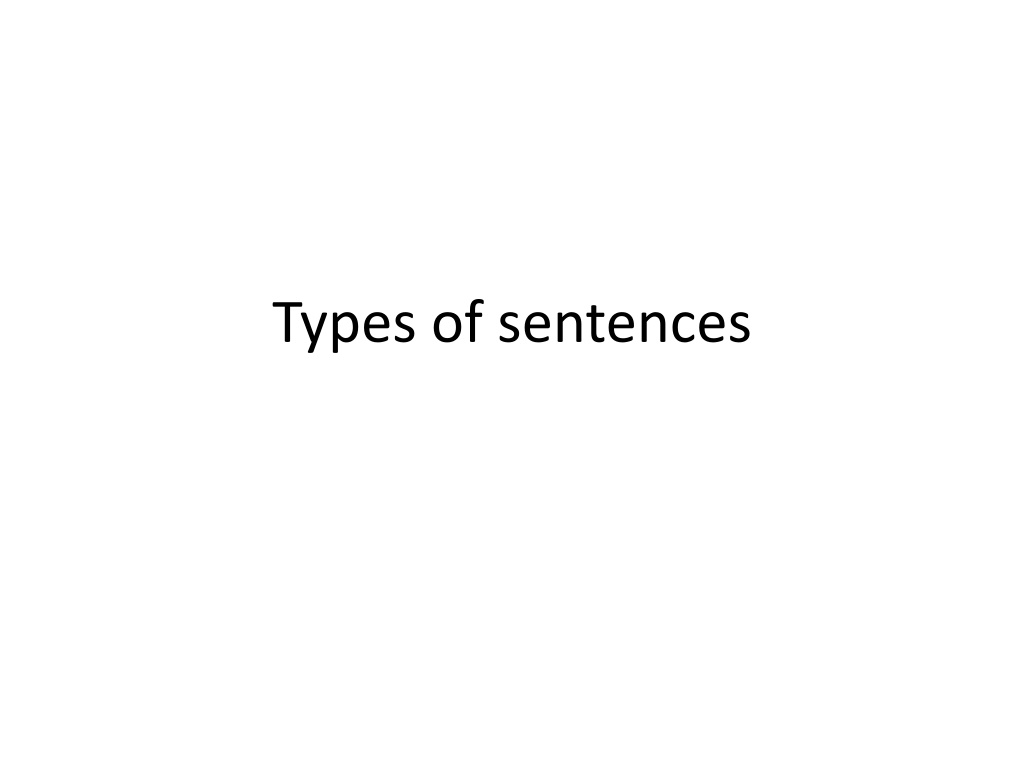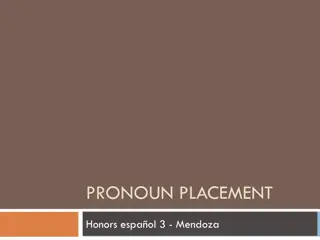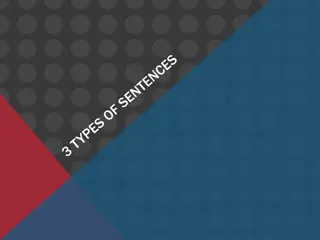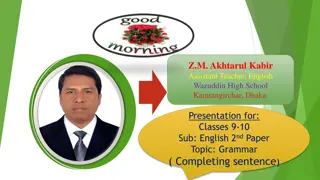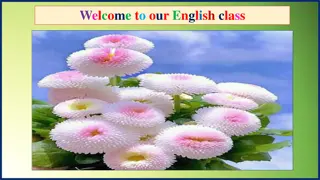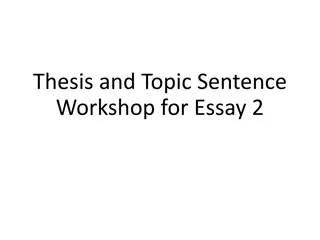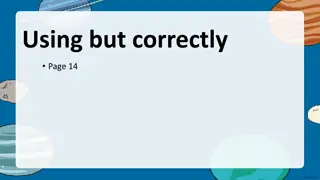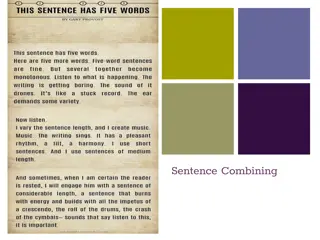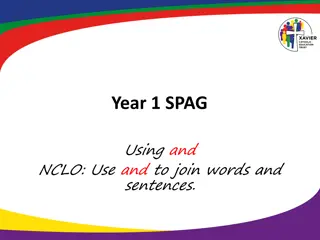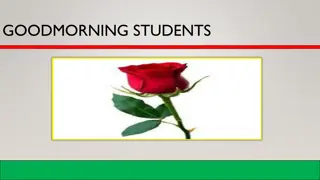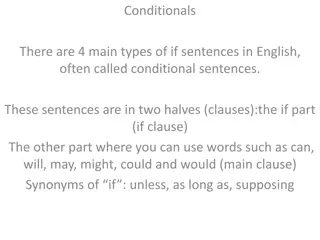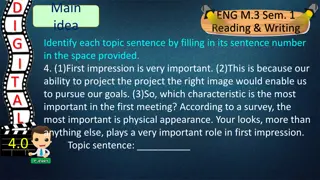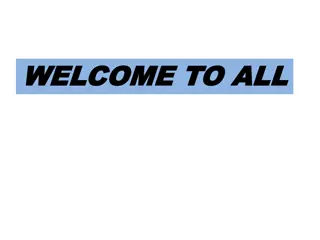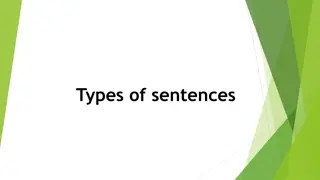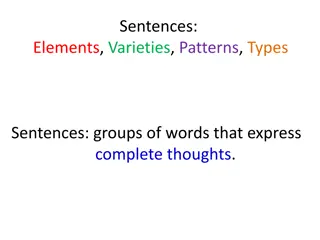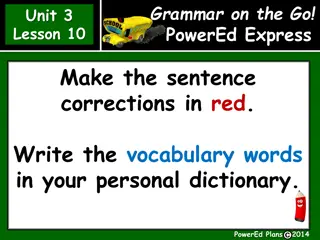Understanding the Four Types of Sentences
Declarative, imperative, interrogative, and exclamatory sentences each serve a unique purpose in communication. Declarative sentences state facts, imperatives give commands, interrogatives ask questions, and exclamatory sentences express strong emotions. By recognizing the characteristics of each type, one can effectively convey thoughts and engage in meaningful dialogue.
Download Presentation

Please find below an Image/Link to download the presentation.
The content on the website is provided AS IS for your information and personal use only. It may not be sold, licensed, or shared on other websites without obtaining consent from the author. Download presentation by click this link. If you encounter any issues during the download, it is possible that the publisher has removed the file from their server.
E N D
Presentation Transcript
1.Declarative sentence A declarative sentence is a type of sentence that makes a statement or provides information. Here are a few examples of declarative sentence 1. "I enjoy reading books." 2. "The cat is sleeping on the couch." 3. "She graduated from university last month." 4. "Water boils at 100 degrees Celsius." 5. "The concert starts at 8 pm." .The purpose of declarative sentences is to convey facts, opinions, descriptions, or information without seeking an answer or posing a question.
2.Imperative sentence An imperative sentence is a type of sentence that gives a command, makes a request, or offers advice or instructions. It is used to express a direct and often urgent statement or instruction. Imperative sentences typically do not have a subject, as the subject is usually understood to be "you," . They often begin with a verb in the base form (infinitive) or with a verb in the base form followed by "please" to make the request more polite. Here are a few examples of imperative sentences: 1. Sit down and be quiet. 2. Please close the door when you leave. 3. Take out the trash before you go to bed. 4. Don't forget to bring your passport. 5. Be sure to double-check your work. In these examples, the imperative sentences are giving commands or instructions to the listener. The verb forms used ("sit," "close," "take," "forget," "be," etc.) show that the sentences are imperative.
3.Interrogative sentence Interrogative sentences, also known as question sentences, are a type of sentence that are formed to ask a question or seek information. These sentences are characterized by their structure and the use of interrogative words (question words) or a question mark at the end. Here are a few examples of interrogative sentences: 1. "What is your favorite color?" 2. "Did you enjoy the movie?" 3. "Where is the nearest library?" 4. "Are you coming to the party?" 5. "How do you make pancake.
4.Exclamatory sentence An exclamatory sentence is a type of sentence that expresses strong emotions, excitement, surprise, or any intense feeling. It is used to convey a strong reaction or to emphasize a certain point. Exclamatory sentences are typically punctuated with an exclamation mark (!) at the end to indicate the heightened emotion. Here are a few examples of exclamatory sentences: 1. "What a beautiful sunset!" 2. "I can't believe we won the game!" 3. "How amazing is that performance!" 4. "What a lovely surprise!" 5. "Wow, that's incredible!"
The past continuous The past continuous tense, also known as the past progressive tense, is used to describe an ongoing action or event that was happening in the past. The past progressive describes an action that was in progress at a specific time in the past .it can be used to describe an action that started in the past and was interrupted by another action .also used for Two ongoing actions happening at the same time: the past progressive tense is formed like this In the affirmative For singular Singular subject+ was +verb[ing] For plural Plural subject +were +verb [ing ] Ex I was studying all night for the exam. I was sleeping when the phone rang. I was reading a book while he was watching TV. They were playing football in the park.
Negation in the past continuous tense To form the negative in the past continuous tense, we use the auxiliary verb "was not" or "were not" followed by the base form of the main verb (verb + ing). Here is the structure for the negative form in the past continuous tense: Subject + was/were + not + verb+ing Here are some examples: 1. I was not studying last night. 2. She was not cooking dinner at that time 3. They were not playing football when it started raining. [[Negative sentences in the past continuous tense indicate that an action was not happening at a specific time in the past.]]
The question is in Past continuous To form questions in the past continuous tense, we use the auxiliary verb "was" or "were" before the subject, followed by the base form of the main verb (verb + ing ). Here is the structure for forming questions in the past continuous tense: Was/Were + subject + verb + ing? Here are some examples: 1. Was I studying last night? 2. Were they playing football when it started raining? 3. Was she cooking dinner at that time?
How do we add ing there are some spelling rules to consider: 1. For verbs ending in "e," drop the "e" and add "ing." Example: Dance Dancing Drive Driving 2. the verb that ends with a consonant-vowel-consonant pattern, double the final consonant before adding "ing." Example: Run Running Swim Swimming If a two-syllable verb ends in a consonant + vowel + consonant, we do not double the final consonant when the stress is on the first syllable. happen . happening enter ..entering offer offering 3. For verbs ending in "ie," change the "ie" to "y" before adding "ing." Example: Lie Lying Die Dying But, we do not double the final consonant when the verb ends in W, X or Y or when the final syllable is not emphasized. Infinitive ING form fix . fixing enjoy . enjoying snow .. snowing
What is the different between past simple and past continuous The main difference between the past simple tense and the past continuous tense is how they describe actions or events in the past. 1. Past Simple Tense: - The past simple tense is used to describe completed actions or events in the past. - It typically expresses a single event that happened at a specific point in time. - Examples: - I studied for the exam last night. - She cooked dinner yesterday. 2. Past Continuous Tense: - The past continuous tense is used to describe ongoing actions or events that were happening in the past. - It emphasizes the duration or progress of an action at a particular time in the past. - Examples: - I was studying all night for the exam. -She was cooking dinner while I was setting the table.
Present continuous tense The present continuous tense is used to describe an action that is happening right now at the time of speaking. It is formed by using the present tense of the verb "to be" (am, is, are) followed by the present participle of the main verb (verb + -ing For example I am eating dinner. or "She is reading a book. This tense can also be used to describe future plans or actions that are already scheduled.
negative To form a negative sentence in the present continuous tense, you use the present tense of the verb "to be" (am not, is not, are not) followed by the present participle of the main verb (verb + -ing). I am not eating dinner. She is not reading a book. I am not watching TV right now. . They are not playing soccer in the park This indicates that the action is not happening at the time of speaking or that it is not a planned action. For example
question The present continuous question case refers to a type of sentence structure used to ask questions about actions or events happening at the present moment. It is formed by using the auxiliary verb "am," "is," or "are" followed by the main verb in its present participle form ( ing form). For example What are you doing? Is she studying? Are you studying for your exam? Is she working on a new project? Is he cooking dinner for us? Are you enjoying your vacation? This structure is commonly used to inquire about ongoing activities
Prepositions [ at, on, in ] At, on, and in are prepositions that are used to indicate location or time in different contexts. - At.. is used to indicate a specific point or location. For example I am at the park. I will see you at school The meeting is at 2 PM. - On.. is used to indicate a surface or a specific day. For example The book is on the table. I have a meeting on Monday. He meet me on oxford street . We are on the bus . The preposition "in" is used to indicate location or position within a specific space or area. . Here are a few examples: The weather is cold in winter l am traveling in december. I was born I 1995 . We are in lraq . I travel in my car .
Complete these time expressions with at, on, in, or no preposition. __ six o'clock. __ Saturday. __ December. __ summer . __1995. __ the weekend. __ January 18
complete the text, using the verbs in the box. 'm enjoying ,'m going to work ,live. started ,'m studying ,come ,can speak, .went My name's Maurizio Celi. I(1) . from Bologna, a city in the north of Italy. I'm a student at the University of Bologna. I (2) ._ modern languages - English and Russian. I also know a little Spanish, so I (3) . four languages. I (4) . the course a lot, but it's really hard work. The course (5) ______ three years ago. I (6) .. _ at home with my parents and my sister. My brother (7) ____to work in the United States last year. After I graduate, I (8) as a translator. I hope so, anyway.
Favourite , variety ,has, only This is the second biggest country in the world, but it has a population of . 30 million. It is so big that there is a of climates. Most people live in the south because the north is too cold. It is famous for its beautiful mountains and lakes - it ..more lakes than any other country. Their sports are baseball and ice hockey
exports ,enjoy, immigrants ,huge This country has quite a small population, just 16 million, but the country is . The people are mainly of European descent, but there are also aborigines and a lot of j south- east Asian . People live in towns on the coast, not so much I inland, because it is so hot. They live a lot of their lives outdoors, And sports, swimming, and having barbecues. This country wine and wool - it has more than 60 million sheep
